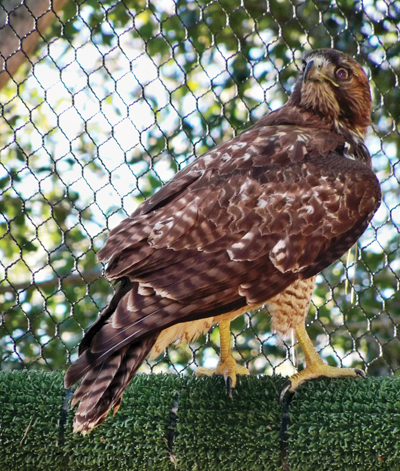Early in December, a driver traveling along Highway 101 near
Gilroy noticed a juvenile red-tailed hawk helplessly flailing by
the side of the road. Thinking quickly, he pulled over, covered the
bird to calm it and to protect himself from its sharp talons, then
brought it the Santa Clara Animal Shelter in San Martin.
Early in December, a driver traveling along Highway 101 near Gilroy noticed a juvenile red-tailed hawk helplessly flailing by the side of the road. Thinking quickly, he pulled over, covered the bird to calm it and to protect himself from its sharp talons, then brought it the Santa Clara Animal Shelter in San Martin. Although the rescuer hadn’t witnessed the incident, it’s assumed that the hawk had suffered a severe concussion when it collided with a vehicle, either while flying across the freeway in pursuit of prey or while standing on the pavement eating road-kill.
The next morning, the alert but weak hawk was transferred to the Wildlife Education and Rehabilitation Center in Morgan Hill. Its initial head-to-foot physical exam showed that she was very plump and muscular – it was obvious that she was a successful hunter and had found plentiful prey to eat. Although she had no visible or palpable injuries – no bleeding, wounds or fractures, and only superficial abrasions on both feet and one partially-splintered talon – the hawk did show signs of neurological injury. She was unbalanced, tilted her head to the side and her right eye was non-responsive to movement, though the pupil dilated to light.
The prognosis was guarded and the hawk was kept under intensive care. Clinic volunteers administered daily pain medication and gave her foot soaks and antibiotics to prevent infections. She could not – or would not – eat on her own, so she needed to be either tube-fed or hand-fed cut-up rodents twice a day.
For six long weeks, the hawk refused to dine on any of the food proffered. Volunteers tried to tempt her with an appetizing assortment of mice, rats and quail, but she turned her beak up at everything. As she had been so plump and well-fed at the time of her rescue, it was thought that maybe she had already developed epicurean preferences for other prey, such as rabbits or ground squirrels, which were not currently available in WERC’s pantry.
In the meantime, because she was still recuperating, she needed sustenance to keep up her strength and aid recovery. Wildlife volunteers had to capture her in the enclosure and force-feed her several times a week, a necessary procedure but certainly not the most pleasant experience for any animal. So it was a wonderful surprise to discover one morning that she was finally eating on her own. And hungrily! From then on, she started eating up to 15 small rodents every day, all by herself. Usually, a captive red-tailed hawk will eat only four to seven mice daily.
In almost a mirror image incidence, a second juvenile red-tailed hawk arrived at the beginning of February under nearly identical circumstances and injuries, including foot abrasions. This hawk also suffered a concussion from a fly-in with a car. However, the latest hawk is a not-so-plump male with visual disturbances to the left eye. He, too, refuses to eat on his own and requires hand-feeding for the time being. Once he begins eating – hopefully not taking one-and-a-half months – he’ll transfer to the flight enclosure and keep company with the female.
It’s essential that raptors be able to focus accurately on fast-moving prey while swooping and maneuvering in flight. Their survival in the wild is dependent on their binocular vision being perfect. To date, both hawks are still non-response in one eye, but WERC is taking a patient, time-will-tell approach, and hopefully, their vision will improve soon and both hawks can be returned to the beautiful blue skies this spring.










